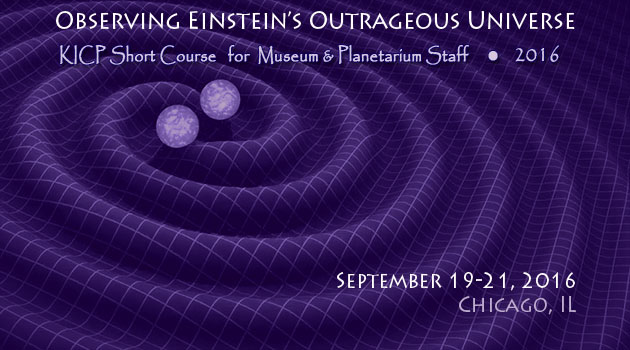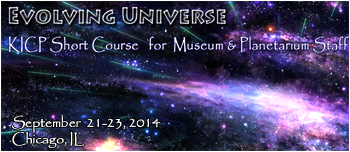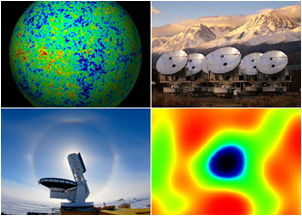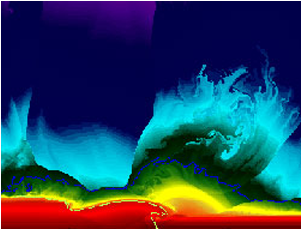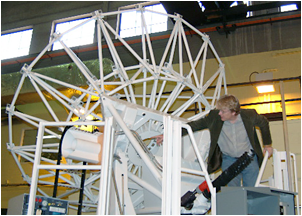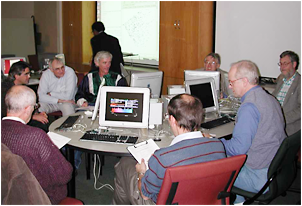- 2016
- "Observing Einstein's Outrageous Universe", Short Course for Museum & Planetarium Staff
- 2014
- "Evolving Universe", Short Course for Museum & Planetarium Staff
- 2012
- "Dark Matters", Short Course for Museum & Planetarium Staff
- 2010
- "The Dark Universe", Cosmology Short Course
- 2007
- "Chicago Maps the Cosmos", Cosmology Short Course
- 2005
- "Big Bang & Beyond, 21st Century Cosmology", Cosmology Short Course
- 2004
- "Extreme Astronomy @ the Planetarium", Cosmology Short Course
- 2003
- "Origin of Structure in the Universe", Cosmology Short Course
- 2001
- "The New Cosmology: From Quantum Fuzz to the Accelerating Universe", Cosmology Short Course
"Observing Einstein's Outrageous Universe", Short Course for Museum & Planetarium Staff
Website
September 19 - 21, 2016
Observing Einstein's Outrageous Universe: Gravitational Waves, Black Holes, Neutron Stars, Gravitational Lenses and the Big Bang
Who Should Attend: Museum & Planetarium Staff
What to Expect:
Course Description
A century ago Einstein put forth his theory of gravity. For the first 50 years it was an exotic theory with many untestable predictions thought to be irrelevant to our Universe. Beginning 50 years ago with the discovery of quasars and the cosmic microwave background (CMB), it has become clear that we live in Einstein’s Universe where the extraordinary is now the ordinary and his theory is in full bloom. To study the Universe today you have to understand the cosmic implications of Einstein's theory. We will focus on observable aspects of some of the most outrageous and compelling predictions of general relativity. These predictions include black holes, gravitational waves, gravitational lensing, and the Big Bang. We will explore the recent detection of gravitational waves from the merger of black holes 30 times the mass of our Sun, the spectacular fireworks associated with the death of stars and the formation of neutron stars and black holes, precise measurements of properties of the supermassive black hole at the center of our galaxy, the bending of light due to the gravity of clusters of galaxies, and how we learn about the origin of space, time, and the earliest moments of the Universe.
September 19 - 21, 2016
Observing Einstein's Outrageous Universe: Gravitational Waves, Black Holes, Neutron Stars, Gravitational Lenses and the Big Bang
Who Should Attend: Museum & Planetarium Staff
What to Expect:
- A better understanding of the BIG Picture of cosmology
- Conversations with leading edge researchers
- A day at the Adler Planetarium & Astronomy Museum to see innovative ways to bring current research into a museum
- Practicum sessions that will allow you test drive programming ideas developed during the course
- Tools and resources to bring the frontiers of physics to your home institution
Course Description
A century ago Einstein put forth his theory of gravity. For the first 50 years it was an exotic theory with many untestable predictions thought to be irrelevant to our Universe. Beginning 50 years ago with the discovery of quasars and the cosmic microwave background (CMB), it has become clear that we live in Einstein’s Universe where the extraordinary is now the ordinary and his theory is in full bloom. To study the Universe today you have to understand the cosmic implications of Einstein's theory. We will focus on observable aspects of some of the most outrageous and compelling predictions of general relativity. These predictions include black holes, gravitational waves, gravitational lensing, and the Big Bang. We will explore the recent detection of gravitational waves from the merger of black holes 30 times the mass of our Sun, the spectacular fireworks associated with the death of stars and the formation of neutron stars and black holes, precise measurements of properties of the supermassive black hole at the center of our galaxy, the bending of light due to the gravity of clusters of galaxies, and how we learn about the origin of space, time, and the earliest moments of the Universe.
"Evolving Universe", Short Course for Museum & Planetarium Staff
Website | Photo Gallery
September 21 - 23, 2014
In our eighth short course KICP researchers will share the most current research about the cosmos focused on the theme of change and evolution. The course will feature a practicum, where teams of participants develop sky show presentations, which will be juried on the final day.
Who Should Attend: Museum & Planetarium Staff
What to Expect:
- A better understanding of the BIG Picture of cosmology
- To meet and talk with researchers at the forefronts
- To visit the Adler Planetarium & Astronomy Museum to see innovative ways to bring current cosmology into a museum
- Practicum sessions that will allow you test drive programming ideas developed during the course
- Tools and resources to bring forefront research into your home institution
Course Description The heavens fixed no more. Discoveries made over the past decade have revealed that the Universe and objects within are changing on timescales from shorter than a microsecond to longer than a billion years. From our own solar system and other planetary systems to stars, galaxies and clusters of galaxies astronomers are chronicling an evolving and evermore interesting universe with their sophisticated instruments.
Though astronomers since antiquity have realized that new objects sometimes appear in the night sky, they considered the cosmos to be timeless and unchanging. Even as recently as the 1920s, astrophysicists had difficulty comprehending a universe that was not eternal. Now we know differently. Change is the rule. Planets form and orbit other stars; stars explode in violent supernovas; galaxies and black holes merge; and the Big Bang set it all in motion.
Astronomers now regularly witness many of these phenomena -- fleets of space satellites and ground based telescopes monitor the sky in real time, detecting transient events like solar flares, gamma ray bursts and supernovae within hours. Telescopes in Antarctica are mapping the spacetime ripples from the Big Bang, the Universe's most dramatic period of evolution. These events let us observe new physics in extreme conditions which are only ever reproduced on Earth in massive computer simulations revealing how galaxies collide and stars explode.
September 21 - 23, 2014
In our eighth short course KICP researchers will share the most current research about the cosmos focused on the theme of change and evolution. The course will feature a practicum, where teams of participants develop sky show presentations, which will be juried on the final day.
Who Should Attend: Museum & Planetarium Staff
What to Expect:
- A better understanding of the BIG Picture of cosmology
- To meet and talk with researchers at the forefronts
- To visit the Adler Planetarium & Astronomy Museum to see innovative ways to bring current cosmology into a museum
- Practicum sessions that will allow you test drive programming ideas developed during the course
- Tools and resources to bring forefront research into your home institution
Course Description The heavens fixed no more. Discoveries made over the past decade have revealed that the Universe and objects within are changing on timescales from shorter than a microsecond to longer than a billion years. From our own solar system and other planetary systems to stars, galaxies and clusters of galaxies astronomers are chronicling an evolving and evermore interesting universe with their sophisticated instruments.
Though astronomers since antiquity have realized that new objects sometimes appear in the night sky, they considered the cosmos to be timeless and unchanging. Even as recently as the 1920s, astrophysicists had difficulty comprehending a universe that was not eternal. Now we know differently. Change is the rule. Planets form and orbit other stars; stars explode in violent supernovas; galaxies and black holes merge; and the Big Bang set it all in motion.
Astronomers now regularly witness many of these phenomena -- fleets of space satellites and ground based telescopes monitor the sky in real time, detecting transient events like solar flares, gamma ray bursts and supernovae within hours. Telescopes in Antarctica are mapping the spacetime ripples from the Big Bang, the Universe's most dramatic period of evolution. These events let us observe new physics in extreme conditions which are only ever reproduced on Earth in massive computer simulations revealing how galaxies collide and stars explode.
"Dark Matters", Short Course for Museum & Planetarium Staff
Website | Photo Gallery
September 26 - 28, 2012
The past twenty years have brought enormous advances in our understanding of the Universe. Evidence from multiple forms of investigation including: precise measurements of the CMB, supernovae, statistical studies of the structures of the Universe, gravitational lensing, baryon acoustic oscillations, theory and phenomenalogical simulations all point to the same concordance model: a Universe that started with a big bang and then went through a brief period of superluminal growth (i.e. inflation); which is currently expanding at an accelerated rate and has a matter energy composition of:
However nice and neat this picture is, it remains full of unknowns. This short course will explore in depth one of the major mysteries on which this model rests: dark matter. It will provide you with the current big cosmological picture, gritty details of the on going searches for dark matter, stories from the forefronts of research and resources that will help you to bring dark matter back to your home institution in a meaningful way. You will meet the individuals behind the headlines and the course format will provide abundant time for informal interactions with them and your peers.
Beyond the big picture and how dark matter fits into this picture, we will delve much deeper into this mysterious stuff that comprises almost a quarter of the universe. We will explore the evidence for the existence of dark matter, what models and experimental evidence point to as potential candidates for the particles that compose dark matter, and how dark matter might be detected. Dark matter detection and detector hardware will be a special focus of this course. We will explore direct detection, indirect detection, accelerator searchers (i.e.., producing it in an accelerator and then detecting the decay particles) and the hardware that makes these searchers possible.
September 26 - 28, 2012
The past twenty years have brought enormous advances in our understanding of the Universe. Evidence from multiple forms of investigation including: precise measurements of the CMB, supernovae, statistical studies of the structures of the Universe, gravitational lensing, baryon acoustic oscillations, theory and phenomenalogical simulations all point to the same concordance model: a Universe that started with a big bang and then went through a brief period of superluminal growth (i.e. inflation); which is currently expanding at an accelerated rate and has a matter energy composition of:
- 72% dark energy
- 23% dark matter
- 4.6% atoms
- 0.4% photons
However nice and neat this picture is, it remains full of unknowns. This short course will explore in depth one of the major mysteries on which this model rests: dark matter. It will provide you with the current big cosmological picture, gritty details of the on going searches for dark matter, stories from the forefronts of research and resources that will help you to bring dark matter back to your home institution in a meaningful way. You will meet the individuals behind the headlines and the course format will provide abundant time for informal interactions with them and your peers.
Beyond the big picture and how dark matter fits into this picture, we will delve much deeper into this mysterious stuff that comprises almost a quarter of the universe. We will explore the evidence for the existence of dark matter, what models and experimental evidence point to as potential candidates for the particles that compose dark matter, and how dark matter might be detected. Dark matter detection and detector hardware will be a special focus of this course. We will explore direct detection, indirect detection, accelerator searchers (i.e.., producing it in an accelerator and then detecting the decay particles) and the hardware that makes these searchers possible.
"The Dark Universe", Cosmology Short Course
Website
September 24 - 26, 2010
For over 70 years, astrophysicists have had indications that much of our universe is made up of dim or invisible material. Today, a wide variety of astronomical observations all point us to the conclusion that the vast majority (about 95%) of the energy and mass in our universe is not made up of atoms, but instead consists of exotic and rather poorly understood substances we call dark matter and dark energy. This short course will discuss what we know about dark matter and dark energy, and how we came to learn that they exist. We will also explore how future experiments might help us to better understand dark matter and dark energy, and roles that they play in our universe's past, present, and future.
September 24 - 26, 2010
For over 70 years, astrophysicists have had indications that much of our universe is made up of dim or invisible material. Today, a wide variety of astronomical observations all point us to the conclusion that the vast majority (about 95%) of the energy and mass in our universe is not made up of atoms, but instead consists of exotic and rather poorly understood substances we call dark matter and dark energy. This short course will discuss what we know about dark matter and dark energy, and how we came to learn that they exist. We will also explore how future experiments might help us to better understand dark matter and dark energy, and roles that they play in our universe's past, present, and future.
"Chicago Maps the Cosmos", Cosmology Short Course
Website
December 7 - 9, 2007
This three-day, intensive short course will highlight cartography on the grandest scales: mapping the cosmos. It will explore the ethereal science of cosmology in the concrete terms of the observed hierarchical structure of the universe - which we have only recently come to understand. Chicago Maps the Cosmos will explore our current understanding of the cosmos from the perspective of those who are at the forefront of investigating it, and it will provide participants with the tools they need to bring the excitement of discovery back to their home institutions. Chicago Maps the Cosmos will also encompass the broader themes of Festival of Maps: Chicago - cartography, discovery, exploration, inspiration and showcasing the local riches of the city of Chicago.
December 7 - 9, 2007
This three-day, intensive short course will highlight cartography on the grandest scales: mapping the cosmos. It will explore the ethereal science of cosmology in the concrete terms of the observed hierarchical structure of the universe - which we have only recently come to understand. Chicago Maps the Cosmos will explore our current understanding of the cosmos from the perspective of those who are at the forefront of investigating it, and it will provide participants with the tools they need to bring the excitement of discovery back to their home institutions. Chicago Maps the Cosmos will also encompass the broader themes of Festival of Maps: Chicago - cartography, discovery, exploration, inspiration and showcasing the local riches of the city of Chicago.
"Big Bang & Beyond, 21st Century Cosmology", Cosmology Short Course
Website
September 23 - 25, 2005
This three day course will take participants to the frontiers of current cosmological research and provide them with the necessary tools to bring the excitement of discovery back to their home institutions. By bringing together the researchers making the discoveries with planetarium/museum/science center staff, who interact daily with the public, this course will help energize the presentation of cosmology in informal educational settings.
This intensive course will establish the framework of standard Big-Bang cosmology and provide insights into recent discoveries into its inner workings. We will follow the evolution of the universe from its earliest moments, about 14 billion years ago when it was a soup of elementary particles, until the present day when it is a tangled web of filaments consisting of galaxies and clusters of galaxies. The observational foundations of our understanding of the universe include measurements of the temperature anisotropy in the cosmic microwave background, the spatial distribution of galaxies and clusters of galaxies, and the expansion history of the universe. On the theoretical side, we will focus on cosmic acceleration at the two ends of time. We will review the predictions of cosmic inflation, acceleration during the short moment of time after the Big Bang, and see how to test them with current and future observations.
September 23 - 25, 2005
This three day course will take participants to the frontiers of current cosmological research and provide them with the necessary tools to bring the excitement of discovery back to their home institutions. By bringing together the researchers making the discoveries with planetarium/museum/science center staff, who interact daily with the public, this course will help energize the presentation of cosmology in informal educational settings.
This intensive course will establish the framework of standard Big-Bang cosmology and provide insights into recent discoveries into its inner workings. We will follow the evolution of the universe from its earliest moments, about 14 billion years ago when it was a soup of elementary particles, until the present day when it is a tangled web of filaments consisting of galaxies and clusters of galaxies. The observational foundations of our understanding of the universe include measurements of the temperature anisotropy in the cosmic microwave background, the spatial distribution of galaxies and clusters of galaxies, and the expansion history of the universe. On the theoretical side, we will focus on cosmic acceleration at the two ends of time. We will review the predictions of cosmic inflation, acceleration during the short moment of time after the Big Bang, and see how to test them with current and future observations.
"Extreme Astronomy @ the Planetarium", Cosmology Short Course
Website
September 24 - 26, 2004
This three-day intensive short course will explore the most violent and mysterious realms of modern astronomy: astronomy of the highest energy phenomena. It will probe the science behind the violent worlds of black holes, neutron stars, active galactic nuclei, supernovae, high energy particles from space, x-ray & gamma-ray bursts as well as the experiments to observe these phenomenon. The instructors will be researchers at the scientific forefront who are trying to understand these incredibly powerful events. The course will provide participants with a firm foundation in modern high energy astronomy. It will also offer practical tools, such as short animations, that will help participants bring this world to a wider audience. Ultimately this KICP course aims to help bring the excitement of discovery into the planetarium and thereby to the public.
September 24 - 26, 2004
This three-day intensive short course will explore the most violent and mysterious realms of modern astronomy: astronomy of the highest energy phenomena. It will probe the science behind the violent worlds of black holes, neutron stars, active galactic nuclei, supernovae, high energy particles from space, x-ray & gamma-ray bursts as well as the experiments to observe these phenomenon. The instructors will be researchers at the scientific forefront who are trying to understand these incredibly powerful events. The course will provide participants with a firm foundation in modern high energy astronomy. It will also offer practical tools, such as short animations, that will help participants bring this world to a wider audience. Ultimately this KICP course aims to help bring the excitement of discovery into the planetarium and thereby to the public.
"Origin of Structure in the Universe", Cosmology Short Course
Website
September 26 - 28, 2003
The Center for Cosmological Physics offers a pioneering short course for planetarium staff aimed at incorporating modern cosmology into public programming.
Forty-six (46) planetarians attended "Origin of Structure in the Universe." They came from as far away as Japan and from planetariums of all sizes (e.g., from inflatable domes to the Hayden Planetarium).
The course was a mixture of lectures, hands-on and computer laboratories, tours of research facilities, and question and answer/discussion sections. Participants were also provided with resources to use back at their home institutions. These resources included short movies and electronic versions of all lectures. A follow-up session, lead by CfCP Director Bruce Winstein, was held at the 2003 annual Great Lakes Planetarium Association (GLPA) meeting in Cleveland. As a subsidiary objective of the short course was to establish a collaborative network, the CfCP also continues to stay in touch with the participants via e-mail and the Internet.
September 26 - 28, 2003
The Center for Cosmological Physics offers a pioneering short course for planetarium staff aimed at incorporating modern cosmology into public programming.
Forty-six (46) planetarians attended "Origin of Structure in the Universe." They came from as far away as Japan and from planetariums of all sizes (e.g., from inflatable domes to the Hayden Planetarium).
The course was a mixture of lectures, hands-on and computer laboratories, tours of research facilities, and question and answer/discussion sections. Participants were also provided with resources to use back at their home institutions. These resources included short movies and electronic versions of all lectures. A follow-up session, lead by CfCP Director Bruce Winstein, was held at the 2003 annual Great Lakes Planetarium Association (GLPA) meeting in Cleveland. As a subsidiary objective of the short course was to establish a collaborative network, the CfCP also continues to stay in touch with the participants via e-mail and the Internet.
"The New Cosmology: From Quantum Fuzz to the Accelerating Universe", Cosmology Short Course
Website
October 26 - 28, 2001
The CfCP offered a three-day intensive short course on cosmology for college faculty. The course was designed to revitalize undergraduate curricula by communicating the latest advances in cosmological research to classroom teachers. The course drew upon the experimental and theoretical strengths of the center and the CfCP's appreciation of their interplay in modern cosmology. This course was a resounding success (see evaluations).
Center members offered participants a solid background and insights into the latest advances in research. Laboratory sessions provided hands-on experiences with leading edge technology (e.g., detecting the cosmic microwave background, CMB) and practical exercises (e.g., use of the web-based Sloan Digital Sky Server, SDSS). Field trips to Fermi National Laboratory and the Adler Planetarium provided additional dimensions to the course (e.g., science on a grand scale and public communication).
Our collaborators - the Chautauqua Organization, Adler Planetarium and Astronomy Museum, Fermi National Accelerator Laboratory, and CARA - enriched the short-course through their involvement and with the leveraged resources they provided. The 35 participants were primarily faculty from non-research undergraduate institutions but included three local high school teachers and three staff members from the American Museum of Natural History who are working on a cosmology exhibit. Course evaluations indicated that The New Cosmology reinvigorated the faculty and gave them practical tools to bring the discoveries at the frontiers of physics back into their classrooms.
October 26 - 28, 2001
The CfCP offered a three-day intensive short course on cosmology for college faculty. The course was designed to revitalize undergraduate curricula by communicating the latest advances in cosmological research to classroom teachers. The course drew upon the experimental and theoretical strengths of the center and the CfCP's appreciation of their interplay in modern cosmology. This course was a resounding success (see evaluations).
Center members offered participants a solid background and insights into the latest advances in research. Laboratory sessions provided hands-on experiences with leading edge technology (e.g., detecting the cosmic microwave background, CMB) and practical exercises (e.g., use of the web-based Sloan Digital Sky Server, SDSS). Field trips to Fermi National Laboratory and the Adler Planetarium provided additional dimensions to the course (e.g., science on a grand scale and public communication).
Our collaborators - the Chautauqua Organization, Adler Planetarium and Astronomy Museum, Fermi National Accelerator Laboratory, and CARA - enriched the short-course through their involvement and with the leveraged resources they provided. The 35 participants were primarily faculty from non-research undergraduate institutions but included three local high school teachers and three staff members from the American Museum of Natural History who are working on a cosmology exhibit. Course evaluations indicated that The New Cosmology reinvigorated the faculty and gave them practical tools to bring the discoveries at the frontiers of physics back into their classrooms.

